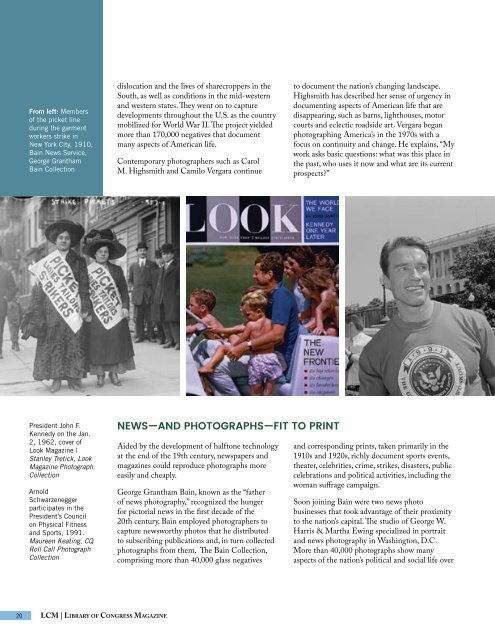THE POWER OF PHOTOGRAPHY
LCM_2016_1112
LCM_2016_1112
You also want an ePaper? Increase the reach of your titles
YUMPU automatically turns print PDFs into web optimized ePapers that Google loves.
From left: Members<br />
of the picket line<br />
during the garment<br />
workers strike in<br />
New York City, 1910,<br />
Bain News Service,<br />
George Grantham<br />
Bain Collection<br />
dislocation and the lives of sharecroppers in the<br />
South, as well as conditions in the mid-western<br />
and western states. They went on to capture<br />
developments throughout the U.S. as the country<br />
mobilized for World War II. The project yielded<br />
more than 170,000 negatives that document<br />
many aspects of American life.<br />
Contemporary photographers such as Carol<br />
M. Highsmith and Camilo Vergara continue<br />
to document the nation’s changing landscape.<br />
Highsmith has described her sense of urgency in<br />
documenting aspects of American life that are<br />
disappearing, such as barns, lighthouses, motor<br />
courts and eclectic roadside art. Vergara began<br />
photographing America’s in the 1970s with a<br />
focus on continuity and change. He explains, “My<br />
work asks basic questions: what was this place in<br />
the past, who uses it now and what are its current<br />
prospects?”<br />
President John F.<br />
Kennedy on the Jan.<br />
2, 1962, cover of<br />
Look Magazine |<br />
Stanley Tretick, Look<br />
Magazine Photograph<br />
Collection<br />
Arnold<br />
Schwarzenegger<br />
participates in the<br />
President’s Council<br />
on Physical Fitness<br />
and Sports, 1991.<br />
Maureen Keating, CQ<br />
Roll Call Photograph<br />
Collection<br />
NEWS—AND PHOTOGRAPHS—FIT TO PRINT<br />
Aided by the development of halftone technology<br />
at the end of the 19th century, newspapers and<br />
magazines could reproduce photographs more<br />
easily and cheaply.<br />
George Grantham Bain, known as the “father<br />
of news photography,” recognized the hunger<br />
for pictorial news in the first decade of the<br />
20th century. Bain employed photographers to<br />
capture newsworthy photos that he distributed<br />
to subscribing publications and, in turn collected<br />
photographs from them. The Bain Collection,<br />
comprising more than 40,000 glass negatives<br />
and corresponding prints, taken primarily in the<br />
1910s and 1920s, richly document sports events,<br />
theater, celebrities, crime, strikes, disasters, public<br />
celebrations and political activities, including the<br />
woman suffrage campaign.<br />
Soon joining Bain were two news photo<br />
businesses that took advantage of their proximity<br />
to the nation’s capital. The studio of George W.<br />
Harris & Martha Ewing specialized in portrait<br />
and news photography in Washington, D.C.<br />
More than 40,000 photographs show many<br />
aspects of the nation’s political and social life over<br />
the course of the first half of the 20th century.<br />
The National Photo Company subscription<br />
service, operated by Herbert French, generated<br />
more than 35,000 photographs starting around<br />
1909 and continuing into the early 1930s.<br />
Pictorial publishing expanded in popular<br />
magazines like Look. The Library of Congress<br />
acquired Look’s photographic archives when<br />
the magazine ceased publication in 1971.<br />
The black-and-white and color images—<br />
many unpublished—invite exploration of the<br />
personalities and pastimes of the 1950s and<br />
1960s.<br />
Similarly, the archives amassed by the New York<br />
World-Telegram & the Sun Newspaper and<br />
the U.S. News & World Report organizations,<br />
together comprising more than 2.2 million<br />
images, include many more photographs than<br />
the publications used. They document major<br />
world crises as well as passing fancies of the 20th<br />
century.<br />
In recent years, the Library has acquired<br />
the photograph collections of Roll Call and<br />
Congressional Quarterly, two publications that<br />
cover activities on Capitol Hill. Comprising<br />
more than 300,000 black-and-white and color<br />
photographs, the images were taken between<br />
1988 and 2000.<br />
Through the Library’s commitment to<br />
preservation and access, these photographs, and<br />
all others in its custody, will continue to move<br />
and inform generations to come.<br />
MORE INFORMATION<br />
View the Library’s Photograph Collections<br />
loc.gov/pictures/collections/<br />
Prints and Photographs Division<br />
loc.gov/rr/print<br />
All photos | Prints and Photographs Division<br />
Barbara Orbach Natanson is head of the Reference Section in the Library’s Prints and Photographs Division.<br />
Television host Ed<br />
Sullivan on stage<br />
with the Beatles,<br />
1965 | New York<br />
World-Telegram and<br />
the Sun Newspaper<br />
Photograph<br />
Collection<br />
20 LCM | Library of Congress Magazine<br />
Nov ember/December 2016 | loc.gov/lcm 21

















